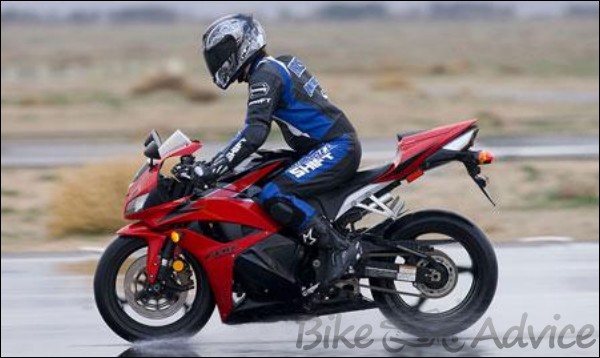Brakes are the most important bit in any motorcycle. If you want to ride safely, with lesser chances of road accidents, you need to L-E-A-R-N proper braking techniques. We often hear opinions from fellow riders that: “I don’t use the front brake, it is too dangerous on my bike” Or “I never use the rear brake, it is completely useless” and so on.
If you are from this clan, you simply need to L-E-A-R-N effective braking.

Do you know which brake is the most important on any motorcycle? If you answered – front brake, you are right. Front brakes provide you with most stopping power (60-80%). If you still don’t believe, you should see these numbers:
Official tests revealed that using both brakes on a standard motorcycle will stop you with mean deceleration of .776 G (gravitational constant). And just the front brake delivers almost stopping force of .711 G!
But when rear brakes are used exclusively, deceleration is significantly lower – only .425 G. Bikes with linked braking systems (LBS or Combined Braking System – CBS) were tested too. Usually, on such motorcycles both brakes get applied in different proportions when only one brake lever/pedal is pressed.
Actually results were lower when using foot pedal or the front brake control only (but brakes are linked together). So even with CBS, using both brakes gave better results (.740 G compared to .583 G or .440G). And the point is – you should always use all brake controls simultaneously, not just the front brake (or the rear brake).
The rear brake is extremely important too. Even on a sportsbike, which usually transfers most of its weight on the front, rear brake use is still needed. You will use that before all the weight is transferred (after that rear brakes will be partially inefficient), and those few moments will decelerate motorcycle greatly.
On cruisers and other heavier bikes rear brake is even more important, because the rear part of the motorcycle will be continuously stable throughout the braking process, and that’s why rear brakes will not lose power just after 1-2 seconds, like on the sportbike.
In addition, rear brake applies stabilizing effect, and holds your rear wheel at the back, without sliding sideways, or hopping around.
Useful tip: During panic braking, do not think of downshifting; just pull in the clutch and brake as hard as possible. Studies showed that downshifting while braking adds few additional meters to your normal stopping distance. So just pull in the clutch and brake.

Of course this needs a lot of practice, you can’t become a “braking expert” overnight. And the thing is – you need to practice braking from higher speeds (like say over 70-80 km/h) not from 25km/h, when you are training in a parking lot. The problem is that braking from the low speeds may seem easy, you just push the brakes hard and that’s all. But in real situation, braking from closer to or over triple digit speeds can be disastrous if you push the brakes to the limit – over-braking will cause loss of control, and you will crash (usually this happens, if the front wheel locks).
This brings in ABS into the picture! Results have proved that ABS results in shortening braking distances. Also ABS eliminates the risk of wheel lock-up and stops are relatively safe. The good news is that ABS is now mandatory on motorcycles over 125 cc in India.
Anti-Lock Braking System (ABS) in Motorcycles – Explained
Some Quick Tips for Braking
- When going downhill, use the front brake. Many riders think that you need to apply brake to the “less stressed” rear wheel in this situation. But it is wrong, it may lock up (loose grip and pass the front). Remember – if a wheel carries lesser weight at any particular moment, it will lock up easier than the wheel with more weight on it.
- Check your front suspension frequently. If you have weak suspension and worn out springs, this could impact your motorcycle’s braking specially under hard braking (you may even lose control). So front suspension in bad condition is dangerous thing.
- While you are riding a heavily loaded motorcycle, or a pillion, make sure you don’t push front brakes too quickly and too strong – wheel will lock immediately if the front springs will be pushed to the limit. You will have to use the rear brake in appropriate proportion.
Ten Things Pillion Riders Should NOT Do!
Finally, how should you brake? A recommended sequence for this procedure is:
- Close the throttle and use the rear brake.
- Straighten the motorcycle if needed, and adjust your posture and hand position.
- Use the front brake and declutch. Don’t squeeze brakes too firmly. Rear brakes shouldn’t be applied at this moment.
- Adjust the brake pressure.
10 Tips to Avoid Accidents While Riding in City: Most Basic But Often Neglected
This whole process usually takes only a few seconds to stop from high speeds and it’s really quick. So in order to do everything right you just need to practice braking – there is no way around it! Mastering braking is an extremely important part of biking and can save you many a times from accidents – minor or major!
– Aleks


